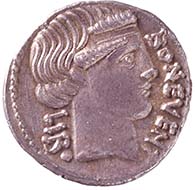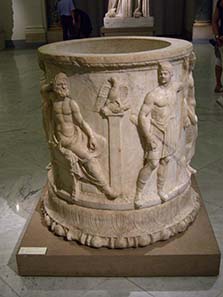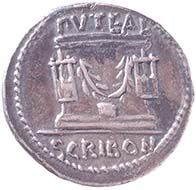PVTEAL reads the inscription above the instrument shown on the reverse of the coin of Lucius Scribonius Libo. Consequently, many coin houses refer in their catalogs to ‘puteal’ when describing what the mint master had put on the reverse of his coins in 62 B. C. What might be a puteal after all? And why had this member of the Scribonii family it put on the reverse of “his” coins?
Denarius of L. Scribonius Libo. From Wyprächtiger Collection. MoneyMuseum, Zurich.
ROMAN REPUBLIC. Lucius Scribonius Libo. Denarius, 62. BON. EVENT – LIBO Head of Bonus Eventus with broad fillet r. Rev. PVTEAL / SCRIBON Puteal Scribonis, decorated with kitharas and garlands; hammer below. Cr. 416/1. Syd. 928.
At first sight, this puteal looks like an ordinary altar, square-shaped, with a little stairway and decorated with garlands. A puteal, however, is no altar; we are deceived by the Republican die cutters’ lack of artistic skill who depict a circular object just the same way as a square-shaped on the coin. The Romans used the term puteal when speaking of a built well shaft covered by a head so that no one was in danger to fall in that dangerous whole. The meaning of the term widened soon. The curb and the covering of thunderbolt graves were called puteal, too.
Thunderbolt grave from the 1st cent. A. D. with depiction of the 12 gods. Naples National Archaeological Museum. Photograph: UK.
This brings us right to our next question: why did the Romans bury their thunderbolts and what did such a thunderbolt grave look like? To answer the first one it is necessary to remember that in ancient Rome the thunderbolt was thought to be sent by Jupiter and thus was considered sacred. Years later, Augustus was to be boasting about a lightning stroke very close to him but without hurting him. He takes it as a sign of agreement sent from God and builds a temple for Jupiter Tonans, thundering Jupiter. Not only Augustus regarded the ground where a lightning stroke sacred and revoked from human usage. Every Roman knew that an area Jupiter claimed his by lightning was prohibited to enter in order not to provoke the god. But, and this leads to the second part of the question, how to protect such a place? A building was erected, similar to the head of well shafts and transferred its name to the thunderbolt grave. In addition, the Puteal Scribonis was given the name of the builders, a member of the mint master’s family, the Scribonii.
Denarius of L. Scribonius Libo. From Wyprächtiger Collection. MoneyMuseum, Zurich.
That might well explain things were it not for some peculiar details causing the puteal to get out of the ordinary. First, there are the objects lying on the stairway of the “well”, hammer, tongs, pileus and anvil. A contemporary replica of the Puteal Scribonis, found in Veii and today on display in Rome, testifies that the die cutter didn’t chose symbols arbitrarily to distinguish emissions – the coins therefore mirror reality.
Denarius of L. Scribonius Libo. From Wyprächtiger Collection. MoneyMuseum, Zurich.
The fourth side of the puteal shows a pileus crowned with laurel. That headgear is an iconographic hint at the god Vulcanus. In Roman religion, he was counterpart of Vesta. Whereas Vesta was the warming hearth fire, destined to be used at home, Vulcanus embodied the wild, consuming flame which destroys houses, erupts from volcanoes but is, on the other hand, required to forge iron and bronze. That was the reason Vulcanus soon merged with Greek god Hephaistion of whom legend had it that he supervised the cyclopes producing the thunderbolts for Zeus, father of gods. That myth was transferred to Vulcanus so that no one will be amazed anymore to find his attributes on a thunderbolt grave.
Denarius of L. Scribonius Libo. From Wyprächtiger Collection. MoneyMuseum, Zurich.
Not only tools are clearly discernible on the coin. Apart from them, we see kitharas and garlands – iconographic details which have nothing whatsoever to do with rather unmusical Vulcanus. Instead, they are indicative of the god Apollon. But what is Apollo’s connection with thunderbolts? Mythology doesn’t provide an explanation. We are, however, given a hint from a different side. Festus, lexikographer from the 2nd cent. A. D., tells us that a man called Scribonius was appointed by the senate with finding the city’s temples that were struck by lightning. That clarifies things: in doing so, that Scribonius probably came across a small sanctuary of Apollon that had been hit by thunder. Subsequently, the servant erected a twin sanctuary for Vulcanus and Apollon in the shape of a puteal on that doubly sacred ground.
But why had a descendant of that servant in 62 B. C. this – presumably not very big and important – building depicted on his coins? Had the Scribonii dynasty so few achievements accomplished in the past and done so little for the people that this small sanctuary was all the mint master had for promotion? Certainly not. It is very likely that Lucius Scribonius Libo didn’t want to emphasize the puteal per se but rather something the puteal stood for in Rome. Horatius, in one of his satires, uses a peculiar term for being required to appear in court. He speaks of seeing each other at the Puteal Scribonis. Apparently, that thunderbolt grave had become synonymous with the proceedings conducted near-by. Hence, first and foremost Libo wanted to hint at the juridical tradition of his family.
The depiction on the obverse points in that direction, too. Nine times out of ten, Republican coins show motifs whose obverse is closely linked to the reverse. If Libo wanted to depict the puteal as a building the coin would have shown in two parallel emissions Apollo on the one hand, Vulcanus on the other. On the obverse he would have shown the two deities the building was dedicated to. Instead we find Bonus Eventus on the obverse, a god from time immemorial of Roman belief. Bonus Eventus guarded and protected the seed’s coming up and thriving.
But just like the peasants became citizens in Rome, he changed his meaning. Bonus Eventus became a god responsible for happy ending and success in general. He thus was a god one truly needed when standing in court where success didn’t depend on right and wrong but on the lawyer’s talent, the favor of the jurymen and the political situation.
The coin of Lucius Scribonius Libo therefore is indicative of the many lawsuits with happy ending his family had carried on near-by the puteal that a member of the very family had erected, in praise of the gods and to the benefit of the state. And apropos of nothing, it shows us one of the most interesting buildings of Republican Rome from all four sides.











